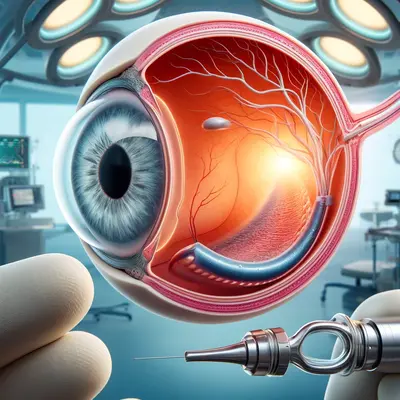For years, individuals like Linda and Marcus have relied heavily on eye drops to manage their glaucoma. Every day, they applied the drops meticulously, hoping to slow the progression of this vision-stealing disease. But what happens when eye drops are no longer enough? In recent years, the management of glaucoma has moved beyond traditional treatment methods, offering innovative solutions for patients looking to protect their sight.
Symptom Breakdown: What is Glaucoma?

Glaucoma, often referred to as the “silent thief of sight,” gradually damages the optic nerve, leading to vision loss if left untreated. Many people are unaware they have the disease until it’s too late, which is why early diagnosis and treatment are crucial.
- Common Symptoms:
- Gradual loss of peripheral vision
- Blurred vision
- Severe eye pain (in cases of acute angle-closure glaucoma)
Glaucoma management traditionally revolved around medicated eye drops to lower intraocular pressure (IOP), but recent innovations provide more comprehensive care.
Diagnostic Path: Innovations in Glaucoma Treatment
Traditionally, eye drops have been the frontline treatment for glaucoma. These drops help reduce intraocular pressure, which is a key factor in slowing the progression of the disease. However, not all patients respond well to drops, and some struggle with compliance, leading to further vision damage. Fortunately, advances in medical technology now offer alternative treatments.
- Micro-invasive Glaucoma Surgery (MIGS):
- How it works: MIGS involves tiny surgical implants that help drain fluid from the eye, reducing pressure. These devices, like the iStent and Hydrus Microstent, are less invasive than traditional surgeries and have quicker recovery times.
- Case Study: After struggling with side effects from drops, 68-year-old Anita opted for MIGS. Within weeks, her intraocular pressure stabilized, and she no longer needed daily drops.
- Laser Treatments:
- Selective Laser Trabeculoplasty (SLT): This laser procedure targets the eye’s drainage system, helping to improve fluid outflow. It’s often recommended when drops fail to control pressure.
- Case Study: Raul, a 55-year-old patient, saw significant improvement after an SLT procedure. His IOP dropped by 30%, and he now enjoys clearer vision without the constant need for eye drops.
- Implantable Devices:
- Innovations like sustained-release implants can deliver medication over months or even years, eliminating the need for daily drops. These devices are often used for patients with compliance issues or those who experience side effects from traditional treatments.
- Case Study: Helen, a busy professional, found it difficult to stick to her eye drop schedule. After receiving a sustained-release implant, her IOP was successfully controlled for over a year without the hassle of daily medication.
Deep Dive: Technology Behind the Devices
The key to these innovations lies in improved fluid drainage and pressure reduction. Devices like the iStent create a small bypass in the eye’s natural drainage system, helping fluid escape more efficiently. Similarly, laser treatments like SLT offer a non-invasive way to increase fluid outflow by gently reshaping the trabecular meshwork of the eye.
As glaucoma research continues, we’re seeing smarter, smaller devices with longer-lasting effects, reducing the burden on patients.
Treatment Comparison: Drops vs. Devices
While medicated eye drops remain a standard treatment for glaucoma, newer devices offer promising alternatives for those who either can’t tolerate drops or need more aggressive treatment.
| Treatment Option | Effectiveness | Duration | Invasiveness | Patient Suitability |
|---|---|---|---|---|
| Eye Drops | Reduces IOP by 20-30% | Daily | Non-invasive | Good for mild cases |
| MIGS (e.g., iStent) | Reduces IOP by 30-50% | Permanent | Minimally invasive | Moderate cases, post-surgery recovery is quicker |
| Laser (SLT) | Reduces IOP by 20-30% | 1-5 years | Non-invasive | For those unresponsive to drops |
| Sustained-release Implants | Reduces IOP by 30-40% | 6-12 months (varies) | Minimally invasive | Good for patients with compliance issues |
Outcome Story: Personalized Glaucoma Management
Take the story of Carl, a 63-year-old retiree who, like many glaucoma patients, was struggling with his daily medication regimen. After multiple consultations, he opted for a MIGS procedure, and his IOP has remained stable ever since. Carl’s experience is just one example of how personalized care is becoming the future of glaucoma management. With options ranging from eye drops to high-tech implants, patients now have more tools than ever to manage their condition and preserve their vision.
Innovations are Shaping the Future of Glaucoma Care
Managing glaucoma has come a long way from the era of eye drops alone. With advancements in micro-surgery, laser treatments, and sustained-release implants, patients like Anita, Raul, and Carl now have more options than ever. These innovations not only improve treatment outcomes but also offer more convenience and better quality of life for patients. If you’re struggling with glaucoma management, now is the time to explore these new solutions with your healthcare provider.
At the end…
“Glaucoma is the leading cause of irreversible blindness worldwide, but early treatment can prevent significant vision loss.” — World Health Organization (WHO).
“Micro-invasive glaucoma surgery (MIGS) is revolutionizing how we manage this chronic disease, offering less invasive options with quicker recovery times.” — American Academy of Ophthalmology (AAO).
“Laser treatments like SLT have shown great promise in reducing intraocular pressure for those who are unresponsive to traditional therapies.” — National Eye Institute (NEI).





